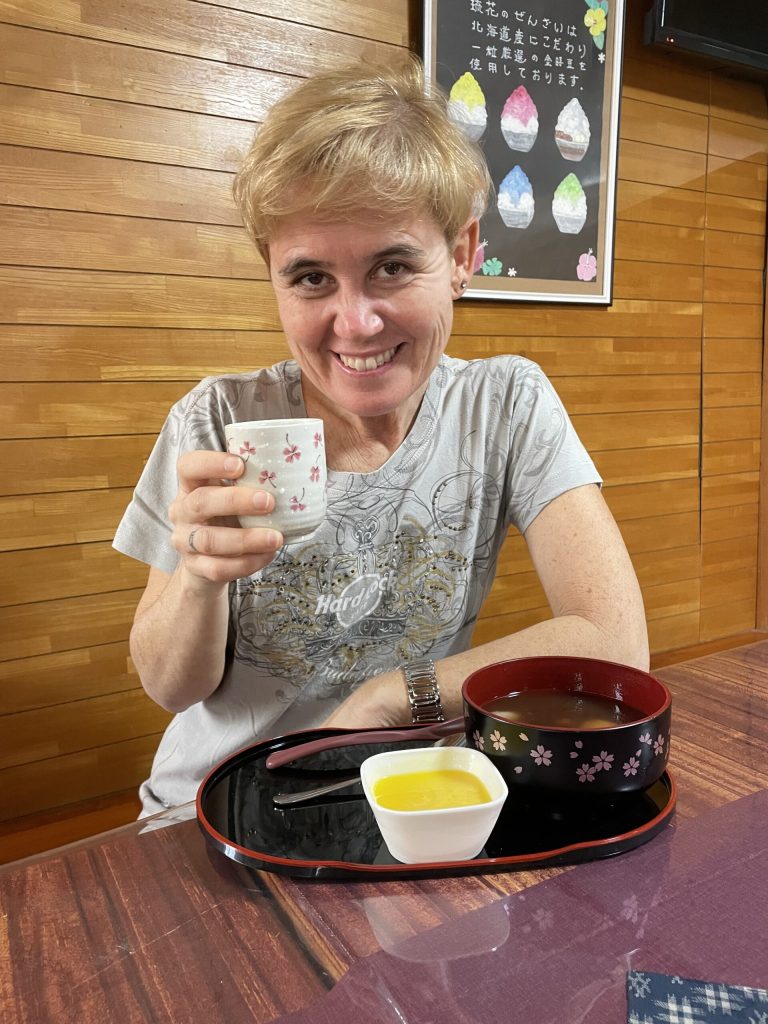Okinawa Zenzai (沖縄ぜんざい) is a traditional sweet from the island of Okinawa, sometimes also called amagashi or koori-zenzai.
It is a variety of zenzai, a Japanese dessert made with sweetened azuki beans served with mochi or glutinous rice.
The Okinawa Zenzai is a unique version that includes tsubuan (azuki bean paste also used to fill dorayaki in its chunkier version) served with crushed ice and tōmochi.
In Okinawa, people often add Okinawa honey or “Kokuto”, the local brown sugar, for a richer flavor, or condensed milk.
We tasted it hot and cold in Okinawa during our trip in March 2025.
The following recipe is the cold version, typical for summer, but in the pictures, you can also see the classic hot one.

- Difficulty: Easy
- Cost: Economical
- Preparation time: 50 Minutes
- Portions: 4 People
- Cooking methods: Boiling, Steaming, Stove
- Cuisine: Japanese
- Seasonality: Spring, Summer
Ingredients
- 5 oz azuki red beans
- 7 oz kokuto (or brown sugar)
- 8 tomochi (or mochi)
- as needed crushed ice
- 1 pinch salt
Steps
Preparation of azuki beans (tsubuan):
Wash the azuki beans and put them in a pot with about 3 1/2 cups of water.
Boil them for about 5-10 minutes, then drain and rinse to remove impurities.
Return the beans to the pot with more water (about 2 1/2 cups) and cook over low heat for about 1 hour or until they become tender.
Add Okinawa brown sugar and cook for another 20-30 minutes until a coarse consistency is achieved (tsubuan).
Preparation of tōmochi – if not using ready-made mochi:
Rinse 7 oz glutinous rice under cold water until the water runs clear. This removes excess starch.
Put the rice in a bowl with cold water and let soak for at least 6-8 hours, preferably overnight. This will help the rice become softer during cooking.
Mix the flour with 3/4 cup of water. If the dough is too hard or too soft, add a little water or glutinous rice flour.Take small portions of mochi and form small blocks or balls. Boil the tōmochi pieces. When the dumplings that have sunk to the bottom of the pot begin to rise to the surface and float (about 5 minutes from the start of cooking), they are cooked.
In a bowl or deep dish, place a generous portion of tsubuan.
Add the tōmochi.
Add a handful of crushed ice.
Garnish with a bit of Okinawa brown sugar.
You can garnish with other typical ingredients, such as mango or other tropical fruits, or add a bit of matcha and whole azuki beans for a different texture, like the version I tasted.You can accompany it with Bukubuku tea, a traditional Okinawan drink often served on special and celebratory occasions.
This unique tea is made by mixing rice with whisked tea leaves, which gives it a unique effervescent flavor.

Zenzai resembles another Japanese dessert: Shiruko. The dishes are similar and based on sweet azuki beans, the main difference lies in the consistency and the way they are served.
Main differences:
Shiruko is more liquid, like a soup, and has a sweet broth base with azuki beans.
Zenzai is denser, like a dessert to be eaten with a spoon, and can include additional ingredients like tōmochi.
Zenzai is a bit more versatile and can be consumed in various ways, including with the addition of ice in the summer (the Okinawa zenzai version).

FAQ (Questions and Answers)
What is Kokuto?
Kokuto is an unrefined sugar, dark in color and rich in flavor, made from sugar cane, but unlike refined white sugar, Kokuto retains more molasses and minerals present in sugar cane.
It is a traditional Okinawan ingredient used in many local recipes, including sweets, drinks, and savory dishes.
It has a deep, earthy flavor, perfect for desserts like zenzai or Kokuto-shiru (a kind of sweet soup).Are tōmochi and mochi the same thing?
No, tōmochi (遠餅) and mochi (餅) are not exactly the same, although both refer to a type of food made from glutinous rice.
Main differences:
Mochi (餅): a traditional Japanese sweet made with glutinous rice pounded into a dense and sticky paste. Mochi can be prepared in various ways and forms, like filled mochi (for example with azuki bean paste), or it can be used in soups, desserts, or even as a base for savory dishes.
Tōmochi (遠餅): is a specific type of mochi found mainly in Okinawa. It is similar to traditional mochi, but often made with glutinous rice from Okinawa and can be softer and less compact than traditional mochi. Tōmochi is also traditionally used in desserts like Okinawa Zenzai, but can also be cooked in other local dishes.
In essence, while tōmochi is a variety of mochi typical of Okinawa without filling, mochi is a generic term used throughout Japan and is usually served with a filling.

